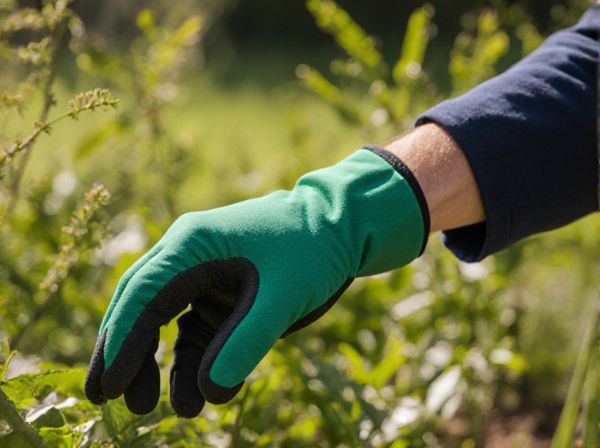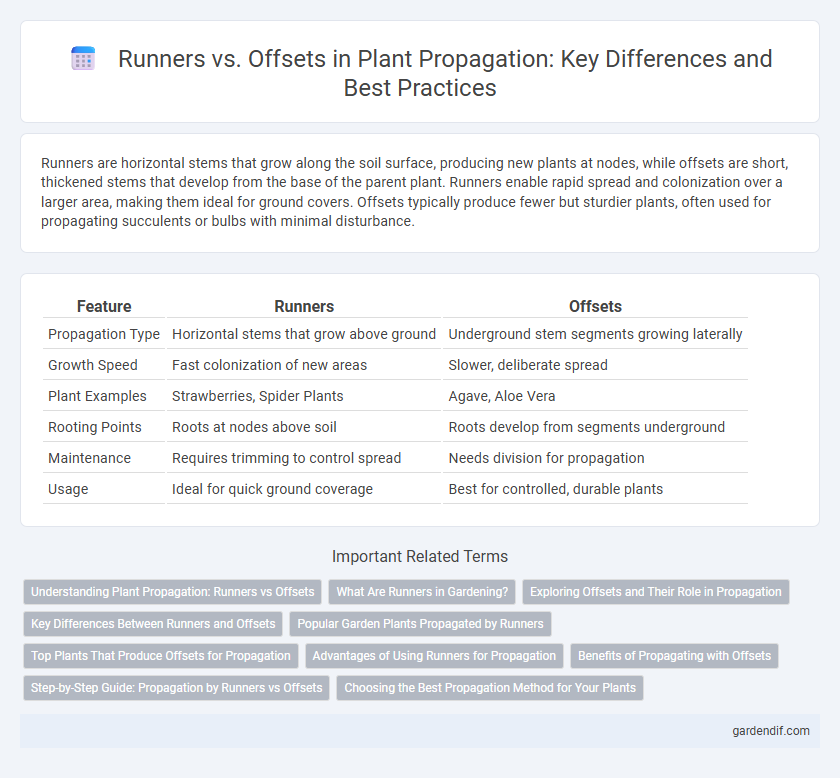
Runners vs Offsets Illustration
Runners are horizontal stems that grow along the soil surface, producing new plants at nodes, while offsets are short, thickened stems that develop from the base of the parent plant. Runners enable rapid spread and colonization over a larger area, making them ideal for ground covers. Offsets typically produce fewer but sturdier plants, often used for propagating succulents or bulbs with minimal disturbance.
Table of Comparison
| Feature | Runners | Offsets |
|---|---|---|
| Propagation Type | Horizontal stems that grow above ground | Underground stem segments growing laterally |
| Growth Speed | Fast colonization of new areas | Slower, deliberate spread |
| Plant Examples | Strawberries, Spider Plants | Agave, Aloe Vera |
| Rooting Points | Roots at nodes above soil | Roots develop from segments underground |
| Maintenance | Requires trimming to control spread | Needs division for propagation |
| Usage | Ideal for quick ground coverage | Best for controlled, durable plants |
Understanding Plant Propagation: Runners vs Offsets
Runners are horizontal stems that grow outward from the parent plant, producing new plants at nodes, commonly seen in strawberries and spider plants. Offsets are small, complete daughter plants that develop directly from the base of the parent, typical in succulents and bromeliads. Understanding these propagation methods helps gardeners choose efficient techniques for plant multiplication based on species and growth habits.
What Are Runners in Gardening?
Runners in gardening are horizontal stems that grow above the soil surface, allowing plants to spread and propagate vegetatively. These stems develop new roots and shoots at nodes, forming independent plants identical to the parent. Common examples include strawberries and spider plants, which use runners to rapidly colonize garden spaces.
Exploring Offsets and Their Role in Propagation
Offsets serve as a crucial method of vegetative propagation, enabling plants like strawberries and blackberries to produce genetically identical offspring. These small shoots develop from the base of the parent plant, eventually forming roots that establish independent plants without relying on seed germination. This natural cloning process ensures rapid colony expansion and is favored for its reliability and uniformity in crop production.
Key Differences Between Runners and Offsets
Runners and offsets are two distinct vegetative propagation methods in plants, with runners being horizontal stems that grow along the soil surface producing new plants at nodes, while offsets are short, vertical shoots that emerge from the base of the parent plant. Runners enable rapid spread and colonization over a larger area, commonly seen in strawberries, whereas offsets typically result in clustered growth near the parent, as observed in plants like aloe vera. The key difference lies in their growth patterns and the spatial distribution of the new progeny, affecting propagation strategy and plant management.
Popular Garden Plants Propagated by Runners
Popular garden plants propagated by runners include strawberries, spider plants, and mint, which produce horizontal stems that root at nodes to form new plants. These runners allow rapid natural spread, enhancing ground cover and plant density without the need for seeds. Gardeners favor this method for its efficiency and the genetic uniformity it ensures in propagated plants.
Top Plants That Produce Offsets for Propagation
Top plants that produce offsets for propagation include aloe vera, spider plants, and daylilies, which generate small clones at the base of the parent plant. These offsets, also known as pups, can be easily separated and replanted to grow new plants identical to the original. Offsets offer a reliable and efficient propagation method, especially for succulent, herbaceous, and some perennial species.
Advantages of Using Runners for Propagation
Runners enable rapid and extensive propagation by producing new plants at intervals along the parent stem, increasing the chances of successful establishment. Their growth does not require specialized care or substrates, making them ideal for low-maintenance and large-scale propagation efforts. Furthermore, runners maintain genetic uniformity, ensuring consistent plant traits across propagated offspring.
Benefits of Propagating with Offsets
Propagating with offsets allows for faster establishment of new plants since offsets are mature, partially developed clones that require less time to root compared to seedlings or runners. This method ensures genetic consistency, preserving desirable traits such as disease resistance and growth patterns inherent in the parent plant. Offsets also reduce variability and increase uniformity in crop production, enhancing yield predictability and quality control in horticulture.
Step-by-Step Guide: Propagation by Runners vs Offsets
Propagation by runners involves using horizontal stems that grow along the soil surface, producing new plants at nodes, ideal for strawberries and spider plants. Propagation by offsets entails separating small, fully formed daughter plants that develop at the base of the parent plant, common in succulents and bromeliads. For effective propagation, select healthy runners with visible nodes or mature offsets, gently separate them with roots intact, and plant in suitable soil to encourage root development and growth.
Choosing the Best Propagation Method for Your Plants
Runners are horizontal stems that grow above the soil, forming new plants at nodes, ideal for strawberry and spider plants due to rapid spread and minimal root disturbance. Offsets are small, complete clones that sprout from the base of the parent plant, perfect for succulents like echeveria and aloe, offering a higher survival rate with established roots. Selecting runners favors fast, extensive coverage in ground-hugging plants, while offsets suit controlled propagation with stronger initial root systems for robustness and ease of transplanting.
Runners vs Offsets Infographic

 gardendif.com
gardendif.com